博主
专辑
- gradle专辑 1
- javaweb专辑 2
- 学习笔记zg4 33
- hutool工具包的使用 13
- Vue3+Element Plus 12
- 跟着禹神学Vue3 1
- 学习笔记zg2(SpringBoot版) 10
- 学习笔记zg2-马 0
- LayUI专辑 14
- 学习笔记zg1 9
第十五节 微服务接口工具Swagger2
1、什么是Swagger?

官网:
https://swagger.io/
2、集成Swagger2
1)、引入依赖包
<!-- swagger2 -->
<!-- https://mvnrepository.com/artifact/io.springfox/springfox-swagger2 -->
<dependency>
<groupId>io.springfox</groupId>
<artifactId>springfox-swagger2</artifactId>
<version>2.9.2</version>
</dependency>
<!-- https://mvnrepository.com/artifact/io.springfox/springfox-swagger-ui -->
<dependency>
<groupId>io.springfox</groupId>
<artifactId>springfox-swagger-ui</artifactId>
<version>2.9.2</version>
</dependency>
2)、增加Swagger配置类
package com.mazong.serverbloguser.config;
import org.springframework.context.annotation.Bean;
import org.springframework.context.annotation.Configuration;
import springfox.documentation.builders.ApiInfoBuilder;
import springfox.documentation.builders.PathSelectors;
import springfox.documentation.builders.RequestHandlerSelectors;
import springfox.documentation.service.ApiInfo;
import springfox.documentation.spi.DocumentationType;
import springfox.documentation.spring.web.plugins.Docket;
import springfox.documentation.swagger2.annotations.EnableSwagger2;
@Configuration
@EnableSwagger2
public class SwaggerConfig {
//api接口包扫描路径
public static final String SWAGGER_SCAN_BASE_PACKAGE = "com.mazong.serverbloguser";
public static final String VERSION = "1.0.0";
@Bean
public Docket createRestApi() {
return new Docket(DocumentationType.SWAGGER_2)
.apiInfo(apiInfo())
.select()
.apis(RequestHandlerSelectors.basePackage(SWAGGER_SCAN_BASE_PACKAGE))
.paths(PathSelectors.any()) // 可以根据url路径设置哪些请求加入文档,忽略哪些请求
.build();
}
private ApiInfo apiInfo() {
return new ApiInfoBuilder()
.title("神码宗") //设置文档的标题
.description("用户 API 接口文档") // 设置文档的描述
.version(VERSION) // 设置文档的版本信息-> 1.0.0 Version information
.termsOfServiceUrl("http://www.shenmazong.com") // 设置文档的License信息->1.3 License information
.build();
}
}
如上代码所示,通过 @Configuration 注解,让 Spring 加载该配置类。再通过 @EnableSwagger2 注解来启用Swagger2。成员方法 createRestApi 函数创建 Docket 的Bean之后,apiInfo() 用来创建该 Api 的基本信息(这些基本信息会展现在文档页面中)。select() 函数返回一个 ApiSelectorBuilder实例用来控制哪些接口暴露给 Swagger 来展现,本例采用指定扫描的包路径来定义,Swagger 会扫描该包下所有 Controller 定义的 API,并产生文档内容(除了被 @ApiIgnore 指定的请求)。
3)、API 接口编写
在完成了上述配置后,其实已经可以产生文档内容,但是这样的文档主要针对请求本身,而描述主要来源于函数等命名产生,对用户并不友好,我们通常需要自己增加一些说明来丰富文档内容。
@Controller
@RequestMapping("/")
@Api(description = "用户API接口")
public class UserController {
@ApiOperation(value="获取用户信息", notes="根据用户ID获取用户信息", produces="application/json")
@ApiImplicitParam(name = "id", value = "用户id", paramType = "query", required = true, dataType = "Integer")
@RequestMapping(value = "/getUser")
@ResponseBody
public Object getUser(@RequestParam("id") Integer id) {
// ...
}
@ApiOperation(value="获取令牌", notes="随机获取用户令牌", produces="application/json")
@RequestMapping(value = "/getToken")
@ResponseBody
public Object getToken() {
// ...
}
}
本接口示例了 @ApiOperation 和 @ApiImplicitParam 两个注解的使用。
- @ApiParam:单个参数描述
- @ApiModel:用对象来接收参数
- @ApiProperty:用对象接收参数时,描述对象的一个字段
- @ApiResponse:HTTP相应其中1个描述
- @ApiResponses:HTTP响应整体描述
- @ApiIgnore:使用该注解忽略这个API
- @ApiError :发生错误返回的信息
- @ApiImplicitParam:描述一个请求参数,可以配置参数的中文含义,还可以给参数设置默认值
- @ApiImplicitParams:描述由多个
- @ApiImplicitParam 注解的参数组成的请求参数列表
4)、运行效果
文档访问地址
http://localhost:8000/swagger-ui.html
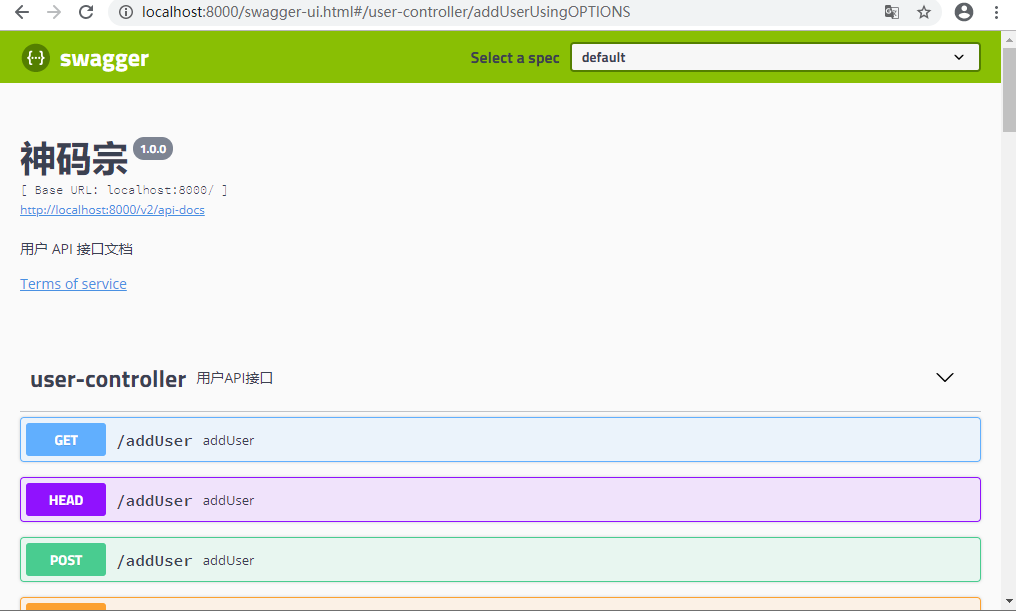
5)、优化文档
(1)设定请求方法、参数定义、返回值定义
@GetMapping(value = "/addUser")
@ResponseBody
@ApiOperation(value = "增加用户", notes="执行增加用户操作")
@ApiImplicitParams({
@ApiImplicitParam(name = "name", value = "用户名", required = true, paramType = "query", dataType = "String"),
@ApiImplicitParam(name = "age", value = "年龄", required = true, paramType = "query", dataType = "int")
})
@ApiResponses({
@ApiResponse(code=4001,message="请求参数没填好"),
@ApiResponse(code=4002,message="请求路径没有或页面跳转路径不对")
})
public String addUser(@RequestParam("name") String name, @RequestParam("age") int age) {
// http://localhost:8000/addUser
TbUser user = new TbUser();
user.setUserName(name);
user.setAge(age);
int id = iUserDbMapper.addUser(user);
System.out.println("addUser="+user.getId());
return user.toString();
}
(2)运行效果
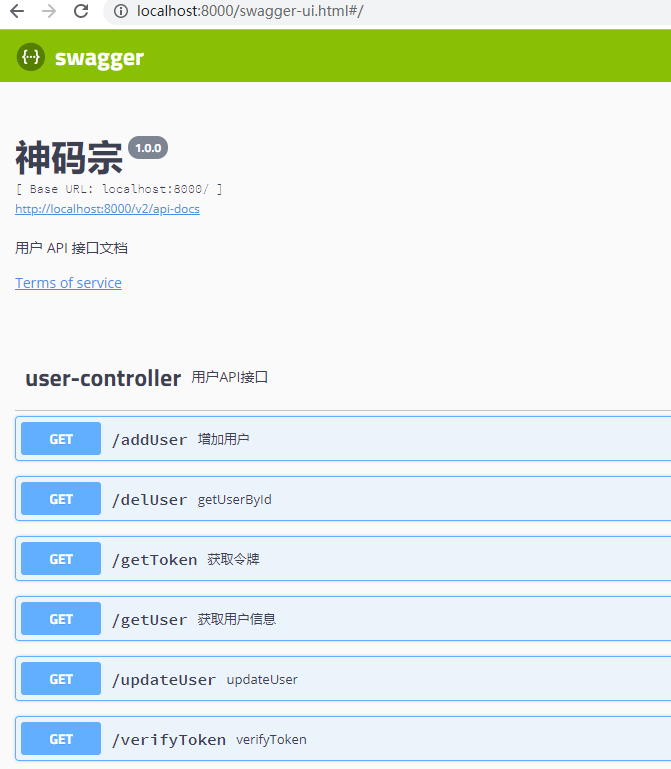
(3)测试接口
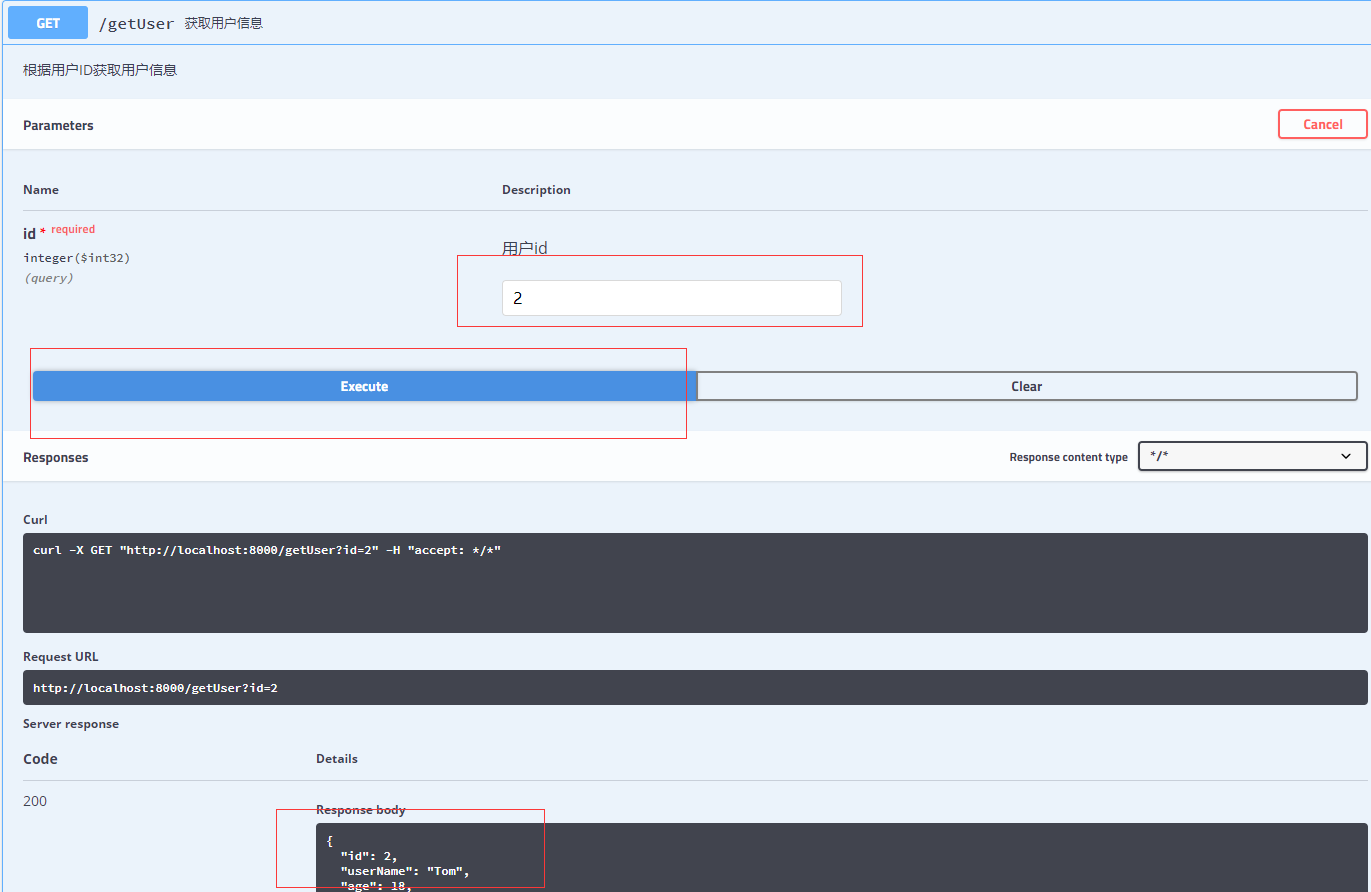
3、Swagger2的注解
1)、常用注解
- @Api:修饰整个类,描述 Controller 的作用
- @ApiOperation:描述一个类的一个方法,或者说一个接口
- @ApiParam:单个参数描述
- @ApiModel:用对象来接收参数
- @ApiProperty:用对象接收参数时,描述对象的一个字段
- @ApiResponse:HTTP 响应其中 1 个描述
- @ApiResponses:HTTP 响应整体描述
- @ApiIgnore:使用该注解忽略这个API
- @ApiError:发生错误返回的信息
- @ApiImplicitParam:一个请求参数
- @ApiImplicitParams:多个请求参数
2)、@Api
说明:用在请求的类上,表示对类的说明
常用参数:
- tags=“说明该类的作用,非空时将覆盖 value 的值” value=“描述类的作用” 其他参数:
- description 对 api 资源的描述,在 1.5 版本后不再支持
- basePath 基本路径可以不配置,在 1.5 版本后不再支持
- position 如果配置多个 Api 想改变显示的顺序位置,在 1.5 版本后不再支持
- produces 设置 MIME 类型列表(output),例:“application/json, application/xml”,默认为空
- consumes 设置 MIME 类型列表(input),例:“application/json, application/xml”,默认为空
- protocols 设置特定协议,例:http, https, ws, wss
- authorizations 获取授权列表(安全声明),如果未设置,则返回一个空的授权值。
- hidden 默认为 false,配置为 true 将在文档中隐藏
@Api(tags="登录请求")
@Controller
public class LoginController {}
3)、@ApiOperation
说明:用在请求的方法上,说明方法的用途、作用
常用参数:
-
value=“说明方法的用途、作用” notes=“方法的备注说明” 其他参数:
-
tags 操作标签,非空时将覆盖value的值 response 响应类型(即返回对象)
-
responseContainer 声明包装的响应容器(返回对象类型)。有效值为 “List”, “Set” or “Map”。
-
responseReference 指定对响应类型的引用。将覆盖任何指定的response()类
-
httpMethod 指定HTTP方法,“GET”, “HEAD”, “POST”, “PUT”, “DELETE”, “OPTIONS” and “PATCH”
-
position 如果配置多个Api 想改变显示的顺序位置,在1.5版本后不再支持
-
nickname 第三方工具唯一标识,默认为空
-
produces 设置MIME类型列表(output),例:“application/json, application/xml”,默认为空
-
consumes 设置MIME类型列表(input),例:“application/json, application/xml”,默认为空
-
protocols 设置特定协议,例:http, https, ws, wss。
-
authorizations 获取授权列表(安全声明),如果未设置,则返回一个空的授权值。
-
hidden 默认为false, 配置为true 将在文档中隐藏
-
responseHeaders 响应头列表 code 响应的HTTP状态代码。默认 200
-
extensions 扩展属性列表数组
@ResponseBody
@PostMapping(value="/login")
@ApiOperation(value = "登录检测", notes="根据用户名、密码判断该用户是否存在")
public UserModel login(@RequestParam(value = "name", required = false) String account,
@RequestParam(value = "pass", required = false) String password){}
4)、@ApiImplicitParams
说明:用在请求的方法上,表示一组参数说明;@ApiImplicitParam:用在 @ApiImplicitParams 注解中,指定一个请求参数的各个方面
常用参数:
-
name:参数名,参数名称可以覆盖方法参数名称,路径参数必须与方法参数一致
-
value:参数的汉字说明、解释
-
required:参数是否必须传,默认为 false (路径参数必填)
-
paramType:参数放在哪个地方
-
header 请求参数的获取:@RequestHeader
-
query 请求参数的获取:@RequestParam
-
path(用于 restful 接口)–> 请求参数的获取:@PathVariable
-
body(不常用)
-
form(不常用)
-
dataType:参数类型,默认 String,其它值 dataType=“Integer”
-
defaultValue:参数的默认值
其他参数(@ApiImplicitParam):
-
allowableValues 限制参数的可接受值。1.以逗号分隔的列表 2.范围值 3.设置最小值/最大值
-
access 允许从API文档中过滤参数。
-
allowMultiple 指定参数是否可以通过具有多个事件接受多个值,默认为 false
example 单个示例
examples 参数示例。仅适用于 BodyParameters
@ResponseBody
@PostMapping(value="/login")
@ApiOperation(value = "登录检测", notes="根据用户名、密码判断该用户是否存在")
@ApiImplicitParams({
@ApiImplicitParam(name = "name", value = "用户名", required = false, paramType = "query", dataType = "String"),
@ApiImplicitParam(name = "pass", value = "密码", required = false, paramType = "query", dataType = "String")
})
public UserModel login(@RequestParam(value = "name", required = false) String account,
@RequestParam(value = "pass", required = false) String password){}
5)、@ApiModel
说明:用于响应类上,表示一个返回响应数据的信息(这种一般用在 POST 创建的时候,使用 @RequestBody 这样的场景,请求参数无法使用 @ApiImplicitParam 注解进行描述的时候);@ApiModelProperty:用在属性上,描述相应类的属性
其他参数(@ApiModelProperty):
-
value 此属性的简要说明。
-
name 允许覆盖属性名称
-
allowableValues 限制参数的可接受值。1.以逗号分隔的列表 2.范围值 3.设置最小值/最大值
-
access 允许从 API 文档中过滤属性。
-
notes 目前尚未使用。
-
dataType 参数的数据类型。可以是类名或者参数名,会覆盖类的属性名称。
-
required 参数是否必要,默认为 false
-
position 允许在类中对属性进行排序。默认为 0
-
hidden 允许在 Swagger 模型定义中隐藏该属性。
-
example 属性的示例。
-
readOnly 将属性设定为只读。
-
reference 指定对相应类型定义的引用,覆盖指定的任何参数值
@ApiModel(value="用户登录信息", description="用于判断用户是否存在")
public class UserModel implements Serializable{
private static final long serialVersionUID = 1L;
/**
* 用户名
*/
@ApiModelProperty(value="用户名")
private String account;
/**
* 密码
*/
@ApiModelProperty(value="密码")
private String password;
}
@ApiModel
public class User {
@ApiModelProperty(value = "用户id")
private Integer id;
@ApiModelProperty(value = "用户名")
private String username;
@ApiModelProperty(value = "用户地址")
private String address;
//getter/setter
}
6)、@ApiResponses
说明:用在请求的方法上,表示一组响应;@ApiResponse:用在 @ApiResponses 中,一般用于表达一个错误的响应信息
常用参数:
-
code:数字,例如 400
-
message:信息,例如 “请求参数没填好”
-
response:抛出异常的类
@ResponseBody
@PostMapping(value="/update/{id}")
@ApiOperation(value = "修改用户信息",notes = "打开页面并修改指定用户信息")
@ApiResponses({
@ApiResponse(code=400,message="请求参数没填好"),
@ApiResponse(code=404,message="请求路径没有或页面跳转路径不对")
})
public JsonResult update(@PathVariable String id, UserModel model){
}
7)、@ApiParam
说明:用在请求方法中,描述参数信息
常用参数:
-
name:参数名称,参数名称可以覆盖方法参数名称,路径参数必须与方法参数一致
-
value:参数的简要说明。
-
defaultValue:参数默认值
-
required:属性是否必填,默认为 false (路径参数必须填)
@ResponseBody
@PostMapping(value="/login")
@ApiOperation(value = "登录检测", notes="根据用户名、密码判断该用户是否存在")
public UserModel login(@ApiParam(name = "model", value = "用户信息Model") UserModel model){
}
其他参数:
-
allowableValues 限制参数的可接受值。1.以逗号分隔的列表 2.范围值 3.设置最小值/最大值
-
access 允许从 API 文档中过滤参数。
-
allowMultiple 指定参数是否可以通过具有多个事件接受多个值,默认为 false
-
hidden 隐藏参数列表中的参数。
-
example 单个示例
-
examples 参数示例。仅适用于 BodyParameters
@ResponseBody
@PostMapping(value="/login")
@ApiOperation(value = "登录检测", notes="根据用户名、密码判断该用户是否存在")
public UserModel login(@ApiParam(name = "name", value = "用户名", required = false) @RequestParam(value = "name", required = false) String account,
@ApiParam(name = "pass", value = "密码", required = false) @RequestParam(value = "pass", required = false) String password){
}
4、注解及参数总结
1)、相关注解
关于其中@Api和@ApiOperation等的详细解释如下:
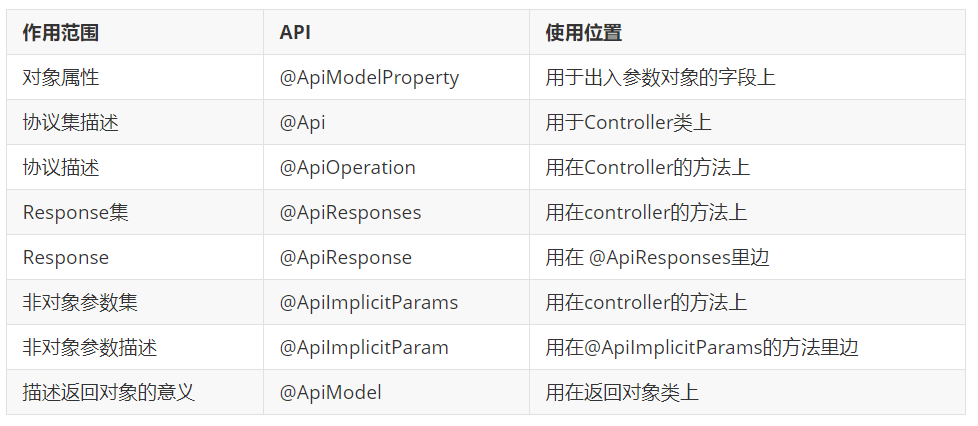
2)、相关参数
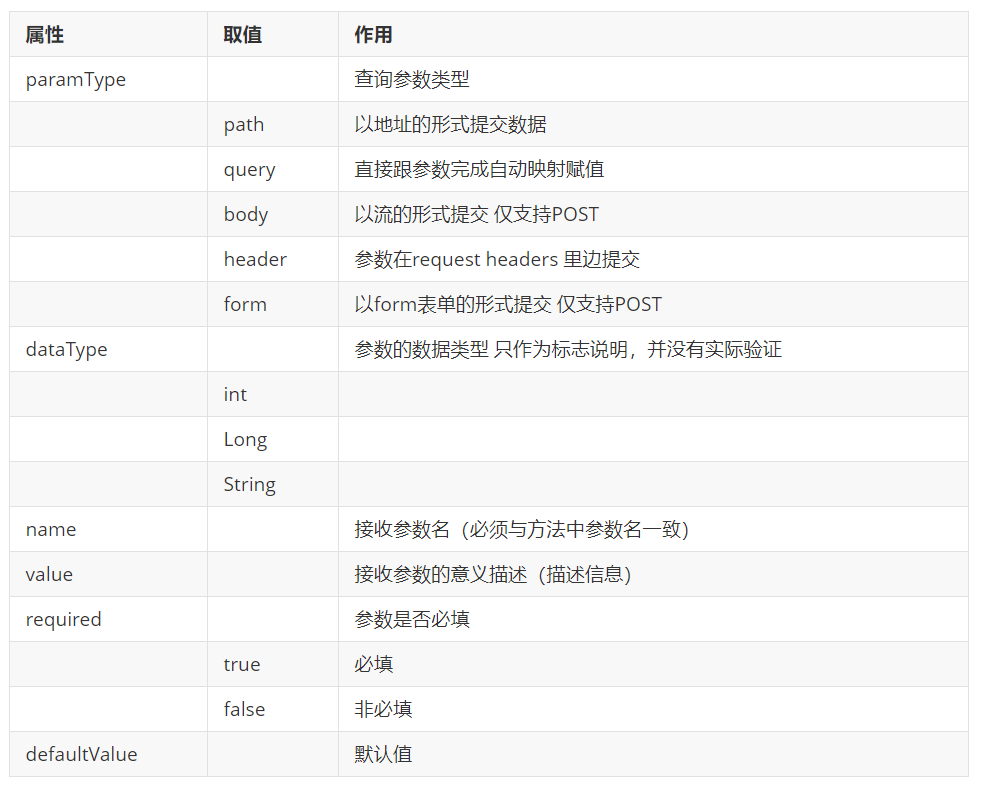
5、SpringBoot中的Swagger2
1)添加依赖
<!-- swagger2 -->
<!-- https://mvnrepository.com/artifact/io.springfox/springfox-swagger2 -->
<dependency>
<groupId>io.springfox</groupId>
<artifactId>springfox-swagger2</artifactId>
<version>2.9.2</version>
</dependency>
<dependency>
<groupId>com.github.xiaoymin</groupId>
<artifactId>swagger-bootstrap-ui</artifactId>
<version>1.9.6</version>
</dependency>
2)、注解和参数没有变化
3)、访问地址
http://localhost:8000/doc.html

这是swagger的两套页面,可以根据自己的喜好,来选择。
6、测试出现的错误
当出现如下错误时,你可能懵了:

类型也对,名字也对,参数值也对,就是无法输入,其实这应该是一个swagger的bug吧,只需要增加一个默认值选项example就可以了,如下代码:
/**
* TODO delSubjectUser 删除科目
* @return
*/
@PostMapping(value = "/delSubjectUser")
@ApiOperation(value = "删除科目", notes = "管理员删除科目")
@ApiOperationSupport(order = 1)
@ApiImplicitParams(value = {
@ApiImplicitParam(name="subjectId", value = "科目ID", dataType = "int", required=true, example = "0")
})
public ResponseResult delSubjectUser(@RequestParam("subjectId") Integer subjectId) {
return tbSubjectService.delSubjectUser(subjectId);
}